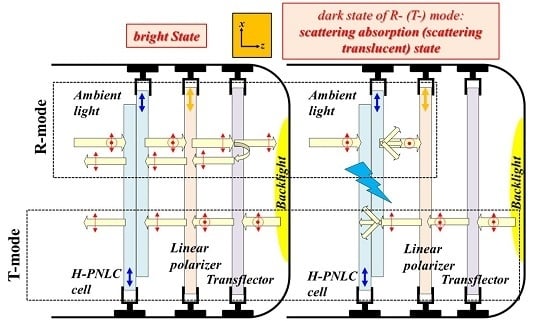High-Contrast and Scattering-Type Transflective Liquid Crystal Displays Based on Polymer-Network Liquid Crystals
Abstract
1. Introduction
2. Materials and Cell Fabrications
3. Two Configurations of the Reported ST-TRLCDs
4. Results and Discussion
4.1. Evaluation of CRs of the Common ST-TRLCDs and the Two SR-TRLCDs Using H-PNLC Cells
4.1.1. Operation Principle of the ST-TRLCD#1 Using an H-PNLC Cell
4.1.2. Operation Principle of the ST-TRLCD#2 Using an H-PNLC Cell
4.1.3. Evaluation of CRs of the Three SR-TRLCDs
4.2. Comparison of CRs of ST-TRLCD#2 Using H-PNLC and PN-90° TNLC Cells
4.2.1. Operation Principle of the ST-TRLCD#2 When the Scattering LC Device is a PN-90° TNLC Cell
4.2.2. Optoelectric Performances of PN-90° TNLC and H-PNLC Cells
4.2.3. Comparison of the Scattering of PN-90° TNLC and H-PNLC Cells
4.3. Other Methods to Enhance CR in ST-TRLCD#2 Using an H-PNLC Cell
5. Conclusions
Author Contributions
Funding
Conflicts of Interest
Appendix A
| Figure 1b | Output of the Dark state of a Common ST-TRLCD |
| T-mode | Output = 1 × 0.5 × 0.96 × 0.5 × 0.96 × α = 0.2304α |
| R-mode | Output = [1 × 0.5 × 0.96 × 0.5 × 0.96 × α] + [1 × (0.5 × β) × 0.96 × 0.5 × 0.96 × (0.5 × α)] + [1× (0.5 × β) × 0.96 × 0.5 × 0.96 × 0.5] = 0.2304α + 0.1152αβ + 0.1152β |
| Figure 3b | Output of the dark state of the reported ST-TRLCD#1 using an H-PNLC cell |
| T-mode | Output = 1 × 0.5 × 0.5 × α = 0.25α |
| R-mode | Output = 1 × (0.5 × β) × 0.5 × 0.5 × α = 0.125αβ |
| Figure 4b | Output of the dark state of the reported ST-TRLCD#2 using an H-PNLC cell |
| T-mode | Output = 1 × 0.5 × (0.5 × α) × 0.5 = 0.125α |
| R-mode | Output) = 1 × 0.5 × β × 0.5 × (0.5 × α) × 0.5 = 0.0625αβ |
References
- Wu, S.T.; Yang, D.K. Reflective Liquid Crystal Displays; Wiley: New York, NY, USA, 2001. [Google Scholar]
- Dierking, I. Polymer Network-Stabilized Liquid Crystals. Adv. Mater. 2000, 12, 167–181. [Google Scholar] [CrossRef]
- Ren, H.; Wu, S.T. Anisotropic liquid crystal gels for switchable polarizers and displays. Appl. Phys. Lett. 2002, 81, 1432–1434. [Google Scholar] [CrossRef]
- Zhu, X.Y.; Ge, Z.B.; Wu, T.X.; Wu, S.T. Transflective Liquid Crystal Displays. J. Disp. Technol. 2005, 1, 15–29. [Google Scholar] [CrossRef]
- Hikmet, R.A.M. Electrically induced light scattering from anisotropic gels with negative dielectric anisotropic. Mol. Cryst. Liq. Cryst. 1992, 213, 117–131. [Google Scholar] [CrossRef]
- Hikmet, R.A.M. Electrically induced light scattering from anisotropic gels. J. Appl. Phys. 1990, 68, 4406–4412. [Google Scholar] [CrossRef]
- Fuh, A.Y.G.; Chih, S.Y.; Wu, S.T. Advanced electro-optical smart window based on PSLC using a photoconductive TiOPc electrode. Liq. Cryst. 2018, 45, 864–871. [Google Scholar] [CrossRef]
- Yamaguchi, R.; Goto, K.; Sakurai, S.; Xiong, L.K.; Tomono, T. Normal and Reverse Mode Light Scattering Properties in Nematic Liquid Crystal Cell Using Polymer Stabilized Effect. J. Photopolym. Sci. Technol. 2015, 28, 319–323. [Google Scholar] [CrossRef]
- Sun, J.; Wu, S.T.; Haseba, Y. A low voltage submillisecond-response polymer network liquid crystal spatial light modulator. Appl. Phys. Lett. 2014, 104, 023305. [Google Scholar] [CrossRef]
- Sun, H.T.; Xie, Z.P.; Ju, C.; Hu, X.W.; Yuan, D.; Zhao, W.; Shui, L.L.; Zhou, G.F. Dye-Doped Electrically Smart Windows Based on Polymer-Stabilized Liquid Crystal. Polymers 2019, 11, 694. [Google Scholar] [CrossRef]
- Fan, Y.H.; Lin, Y.H.; Ren, H.; Gauza, S.; Wu, S.T. Fast-response and scattering-free polymer network liquid crystals for infrared light modulators. Appl. Phys. Lett. 2004, 84, 1233–1235. [Google Scholar] [CrossRef]
- Yamaguchi, R.; Goto, K.; Yaroshchuk, O. Electro-optical properties and morphology of reverse scattering mode TN LCD. J. Photopolym. Sci. Technol. 2012, 25, 313–316. [Google Scholar] [CrossRef]
- Lu, Y.Q.; Du, F.; Lin, Y.H.; Wu, S.T. Variable optical attenuator based on polymer stabilized twisted nematic liquid crystal. Opt. Express 2004, 12, 1221–1227. [Google Scholar] [CrossRef] [PubMed]
- Bos, P.J.; Rahman, J.A.; Doane, J.W. A low-threshold-voltage polymer network TN device. SID Dig. Tech. Pap. 1993, 24, 877–880. [Google Scholar]
- Yamaguchi, R.; Xiong, L. Reverse-mode liquid crystal gels with twisted orientation. Jpn. J. Appl. Phys. 2010, 49, 060203. [Google Scholar] [CrossRef]
- Liu, C.K.; Cheng, W.S.; Cheng, K.T. Asymmetrical polarization-dependent scattering and reflection in a sole cell of polymer network-90° twisted nematic liquid crystals. Opt. Express 2017, 25, 22388–22403. [Google Scholar] [CrossRef]
- Liu, C.K.; Tu, C.Y.; Liu, Y.X.; Chen, W.H.; Cheng, K.T. General theory of asymmetrical polarization dependent optics in functional material-doped 90° twisted nematic liquid crystals. Opt. Express 2018, 26, 17115–1717131. [Google Scholar] [CrossRef]
- Liu, C.K.; Cheng, K.T. Enhancement of surface anchoring energy in low power consumption transflective liquid crystal displays with three display modes. Opt. Commun. 2018, 427, 354–362. [Google Scholar] [CrossRef]
- Chu, F.; Dou, H.; Tian, L.L.; Li, R.; Hou, W.Y.; Li, L.; Wang, Q.H. A simple transflective liquid crystal display with composite dielectric layer. Liq. Cryst. 2019, 46, 1790–1798. [Google Scholar] [CrossRef]
- Yang, Y.S.; Huang, Y.P.; Shieh, H.P.D.; Tsai, M.C.; Tsai, C.Y. Applications of Microtube Array on Transflective Liquid Crystal Displays for Backlight Efficiency Enhancement. Jpn. J. Appl. Phys. 2004, 43, 8075–8079. [Google Scholar] [CrossRef]
- Chien, K.W.; Shieh, H.P.D.; Cornelissen, H.J. Efficient Polarized Backlight for Transflective Liquid Crystal Display Illumination. Jpn. J. Appl. Phys. 2005, 44, 1818–1819. [Google Scholar] [CrossRef]
- Shin, H.K.; Yoon, T.H.; Kim, J.C. Brightness Improved Transflective Liquid Crystal Display by Using Microlens Arrays. Jpn. J. Appl. Phys. 2007, 46, 6685–6687. [Google Scholar] [CrossRef]
- Fuh, A.Y.G.; Huang, C.Y.; Liu, C.K.; Chen, Y.D.; Cheng, K.T. Dual liquid crystal alignment configuration based on nanoparticle-doped polymer films. Opt. Express 2011, 19, 18525–18531. [Google Scholar] [CrossRef] [PubMed]
- Wang, Q.H.; Chu, F.; Dou, H.; Tian, L.L.; Li, R.; Hou, W.Y. A single-cell-gap transflective liquid crystal display with a vertically aligned cell. Liq. Cryst. 2019, 46, 1183–1190. [Google Scholar] [CrossRef]
- Lee, S.H.; Do, H.W.; Lee, G.D.; Lee, G.D.; Yoon, T.H.; Kim, J.C. A novel transflective liquid crystal display with a periodically patterned electrode. Jpn. J. Appl. Phys. 2003, 42, L1455–L1458. [Google Scholar] [CrossRef]
- Cui, H.Q.; Ye, Z.C.; Hu, W.; Lin, X.W.; Chung, T.C.; Jen, T.S.; Lu, Y.Q. Single cell gap polymer-stabilized blue-phase transflective LCDs using internal nanowire grid polarizer. J. Inf. Disp. 2011, 12, 115–119. [Google Scholar] [CrossRef]
- Weng, L.B.; Liao, P.C.; Lin, C.C.; Ting, T.L.; Hsu, W.H.; Su, J.J.; Chien, L.C. Anchoring energy enhancement and pretilt angle control of liquid crystal alignment on polymerized surfaces. AIP Adv. 2015, 5, 097218. [Google Scholar] [CrossRef]
- Chen, H.W.; Lee, J.H.; Lin, B.Y.; Chen, S.; Wu, S.T. Liquid crystal display and organic light-emitting diode display: Present status and future perspectives. Light Sci. Appl. 2018, 7, 17168. [Google Scholar] [CrossRef]
- Bhowmik, A.K.; Li, Z.L.; Bos, P.J. Mobile Displays: Technology and Applications; Wiley: New York, NY, USA, 2008. [Google Scholar]
- Lee, Y.H.; Gou, F.W.; Peng, F.L.; Wu, S.T. Hysteresis-free and submillisecond-response polymer network liquid crystal. Opt. Express 2016, 24, 14793–14800. [Google Scholar] [CrossRef]
- Raut, H.K.; Ganesh, V.A.; Nair, A.S.; Ramakrishna, S. Anti-reflective coatings: A critical, in-depth review. Energy Environ. Sci. 2011, 4, 3779–3804. [Google Scholar] [CrossRef]
- Sun, J.; Chen, Y.; Wu, S.T. Submillisecond-response and scattering-free infrared liquid crystal phase modulators. Opt. Express 2012, 20, 20124–20129. [Google Scholar] [CrossRef]
- Apetz, R.; Bruggen, M.P.B.V. Transparent Alumina: A Light-Scattering Model. J. Am. Ceram. Soc. 2003, 86, 480–486. [Google Scholar] [CrossRef]
- Fung, Y.K.; Borstnik, A.; Zumer, S.; Yang, D.K.; Doane, J.W. Pretransitional Nematic Ordering in Liquid Crystals with Dispersed Polymer Networks. Phys. Rev. E 1997, 55, 1637–1645. [Google Scholar] [CrossRef]
- Yeh, P.; Gu, C. Optics of Liquid Crystal Display; Wiley: New York, NY, USA, 1999. [Google Scholar]
- Chen, H.W.; Zhu, R.D.; Tan, G.J.; Li, M.C.; Lee, S.L.; Wu, S.T. Enlarging the color gamut of liquid crystal displays with a functional reflective polarizer. Opt. Express. 2017, 25, 102–111. [Google Scholar] [CrossRef] [PubMed]
- Liu, C.K.; Yang, T.H.; Cheng, K.T. Expanding color gamut of reflective liquid crystal displays from filtering undesirable wavelengths of a light source by an embedded etalon. Appl. Opt. 2017, 56, 1880–1885. [Google Scholar] [CrossRef] [PubMed]
- Tosini, G.; Ferguson, I.; Tsubota, K. Effect of blue light on the circadian system and eye physiology. Mol. Vis. 2016, 22, 61–72. [Google Scholar] [PubMed]
- Wu, D.Y.; Pang, D.B. Taurine reduces blue light-induced retinal neuronal cell apoptosis in vitro. Cutan. Ocul. Toxicol. 2018, 37, 240–244. [Google Scholar]
- Stringham, J.M.; Stringham, N.T.; O’Brien, K.J. Macular Carotenoid Supplementation Improves Visual Performance, Sleep Quality, and Adverse Physical Symptoms in Those with High Screen Time Exposure. Foods 2017, 6, 47. [Google Scholar] [CrossRef]
- Zhang, J.J.; Guo, W.H.; Xie, B.; Yu, X.J.; Luo, X.B.; Zhang, T.; Yu, Z.H.; Wang, H.; Jin, X. Blue light hazard optimization for white light-emitting diode sources with high luminous efficacy of radiation and high color rendering index. Opt. Laser. Technol. 2017, 94, 193–198. [Google Scholar] [CrossRef]
- Kawatsuki, N.; Uchida, E.; Ono, H. Formation of pure polarization gratings in 4-methoxyazobenzene containing polymer films using off-resonant laser light. Appl. Phys. Lett. 2003, 83, 4544–4546. [Google Scholar] [CrossRef]
- Fuh, A.Y.G.; Chen, W.K.; Cheng, K.T.; Liu, Y.C.; Liu, C.K.; Chen, Y.D. Formation of holographic gratings in polymer-dispersed liquid crystals using off-resonant light. Opt. Mater. Express 2015, 5, 774–780. [Google Scholar] [CrossRef]
- Ramsey, R.A.; Sharma, S.C. Switchable holographic gratings formed in polymer-dispersed liquid-crystal cells by use of a He-Ne laser. Opt. Lett. 2005, 30, 592–594. [Google Scholar] [CrossRef] [PubMed]
- Jahanbakhsh, F.; Lorenz, A. Impact of co-doping concentration in copolymer network liquid crystals. Liq. Cryst. 2019, 46, 1485–1493. [Google Scholar] [CrossRef]
- Lorenz, A.; Omairat, F.; Braun, L.; Kolosova, V. Nematic copolymer network LCs for swift continuous phase modulation and opaque scattering states. Mol. Cryst. Liq. Cryst. 2017, 646, 220–225. [Google Scholar] [CrossRef][Green Version]
- Habibpourmoghadam, A.; Wolfram, L.; Jahanbakhsh, F.; Mohr, B.; Reshetnyak, V.Y.; Lorenz, A. Tunable Diffraction Gratings in Copolymer Network Liquid Crystals Driven with Interdigitated Electrodes. ACS Appl. Electron. Mater. 2019, 1, 2574–2584. [Google Scholar] [CrossRef]
- Shen, W.B.; Wang, L.; Zhong, T.J.; Chen, G.; Li, C.X.; Chen, M.; Zhang, C.H.; Zhang, L.Y.; Li, K.X.; Yang, Z.; et al. Electrically switchable light transmittance of epoxy-mercaptan polymer/nematic liquid crystal composites with controllable microstructures. Polymer 2019, 160, 53–64. [Google Scholar] [CrossRef]
- Shen, W.B.; Wang, L.; Chen, G.; Li, C.X.; Zhang, L.Y.; Yang, Z.; Yang, H. A facile route towards controllable electric-optical performance of polymer-dispersed liquid crystal via the implantation of liquid crystalline epoxy network in conventional resin. Polymer 2019, 167, 67–77. [Google Scholar] [CrossRef]
- Wang, M.; Zou, C.; Sun, J.; Zhang, L.Y.; Wang, L.; Xiao, J.M.; Li, F.S.; Song, P.; Yang, H. Asymmetric Tunable Photonic Bandgaps in Self-Organized 3D Nanostructure of Polymer-Stabilized Blue Phase I Modulated by Voltage Polarity. Adv. Funct. Mater. 2017, 27, 1702261. [Google Scholar] [CrossRef]

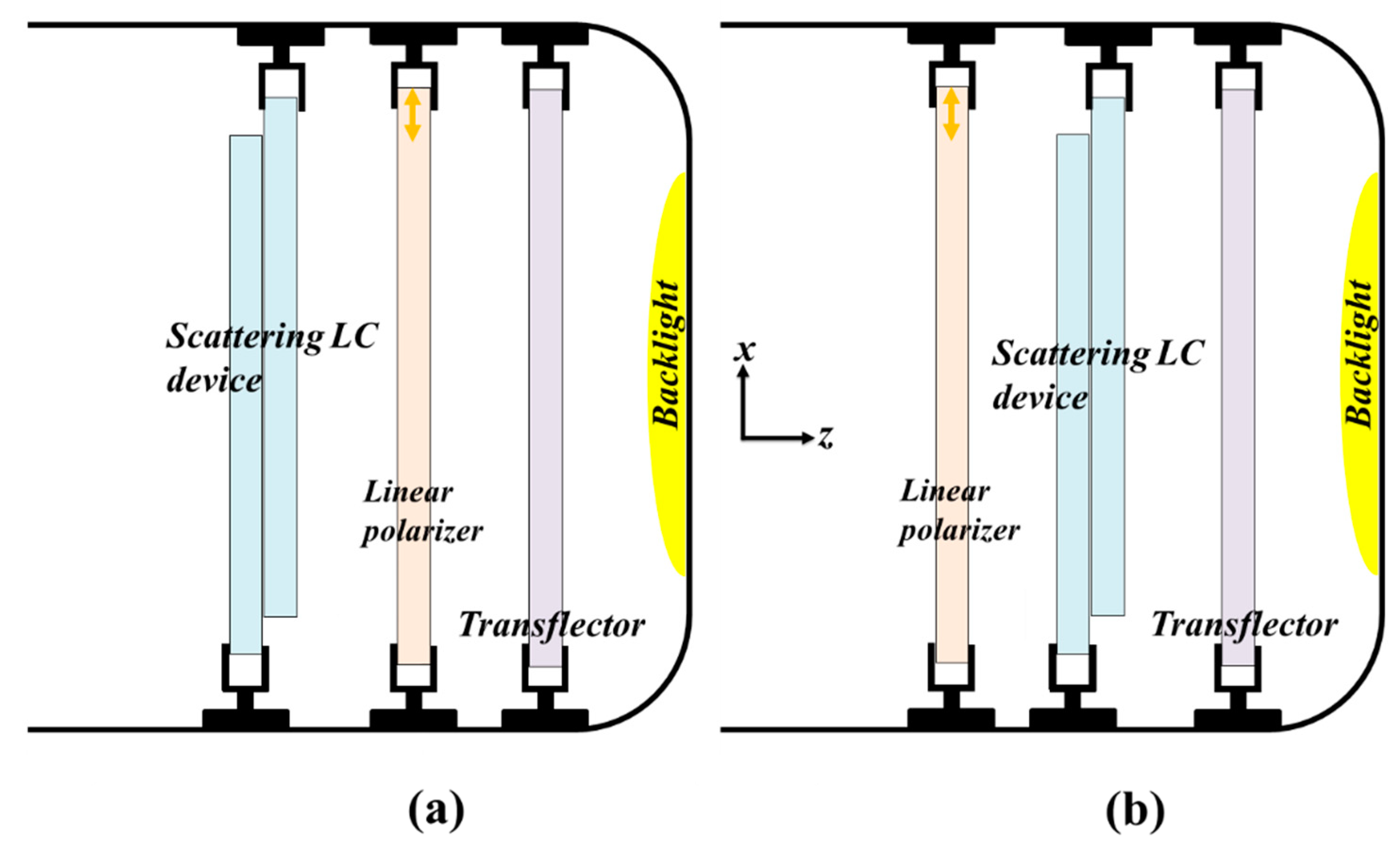
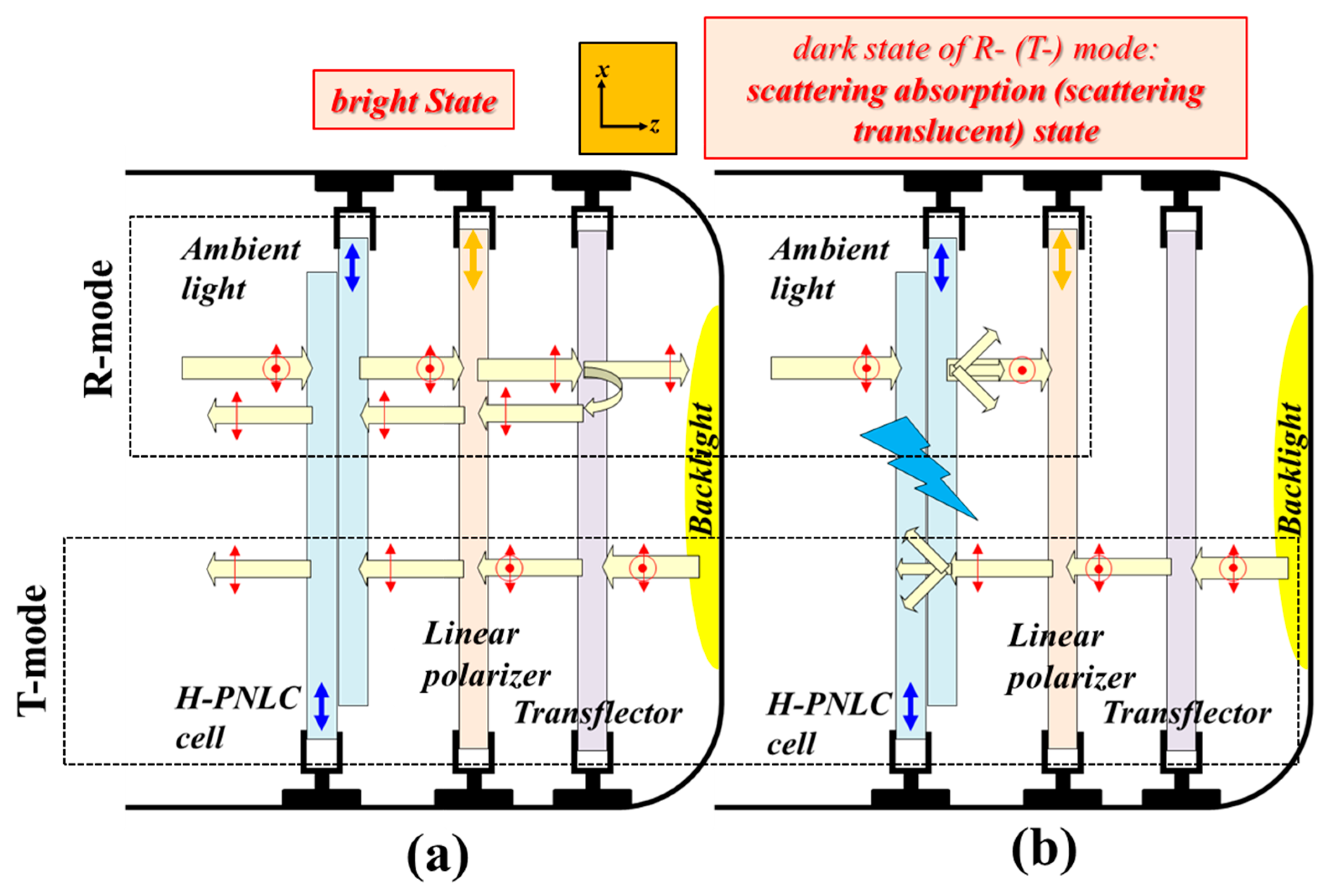
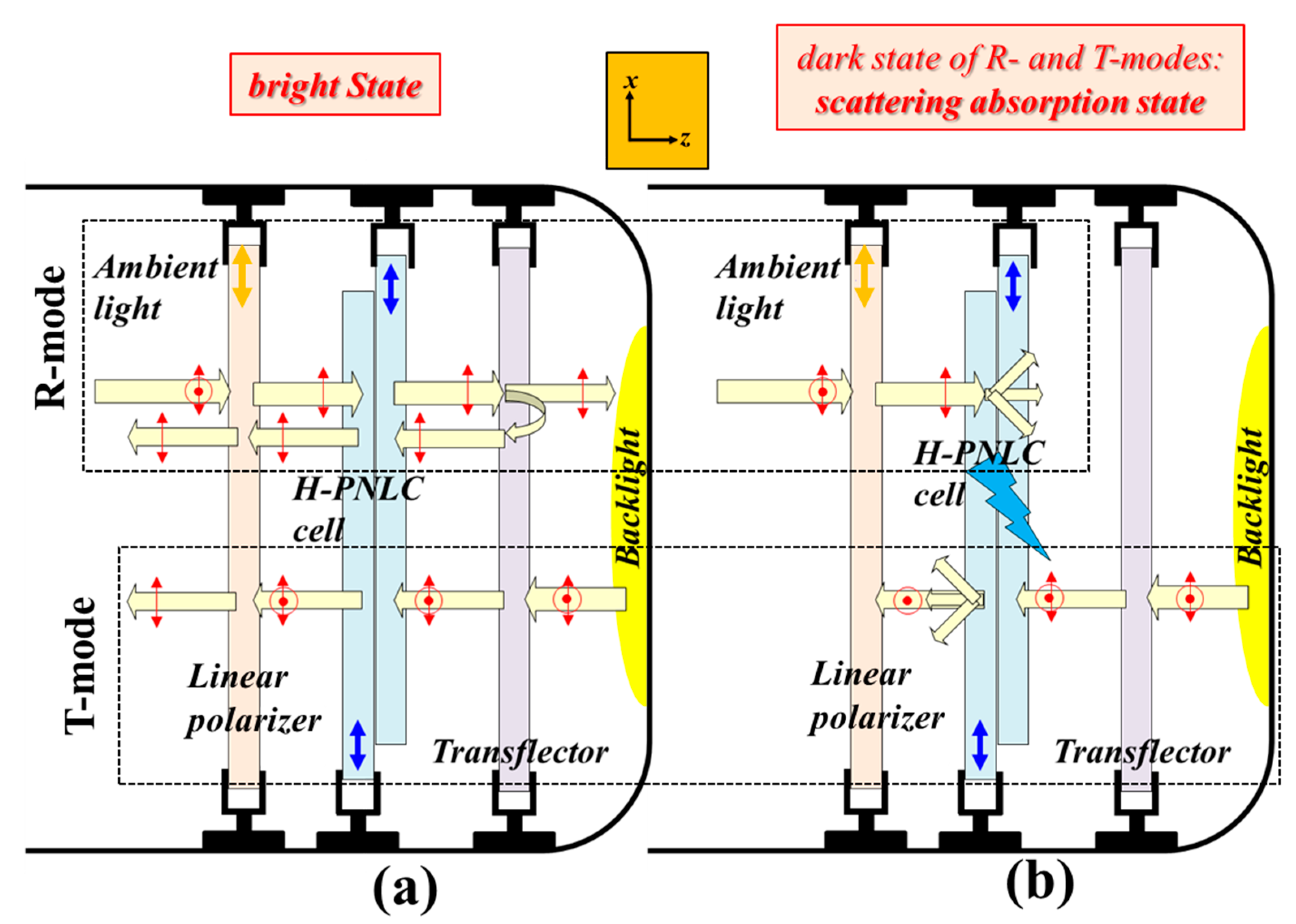
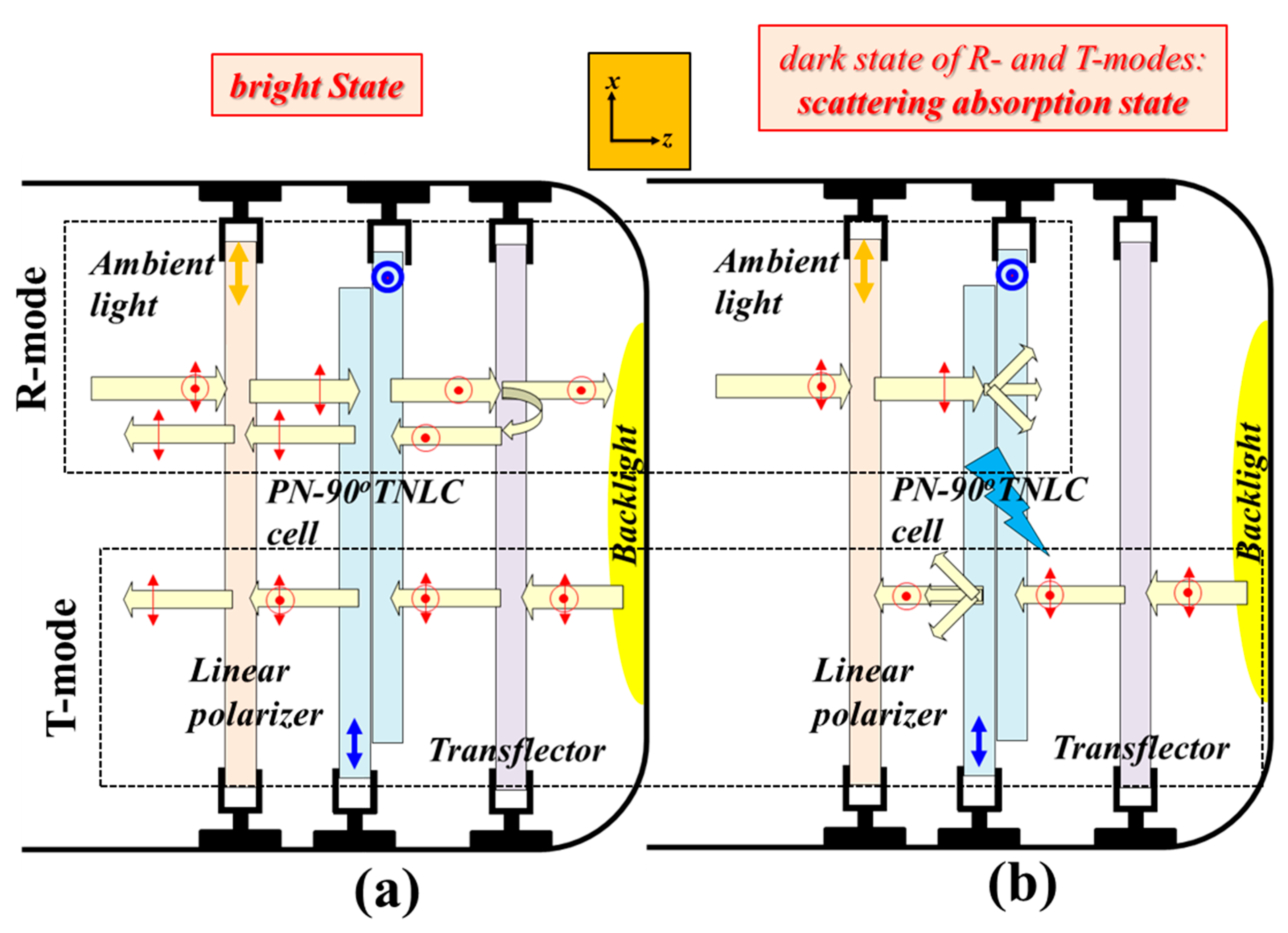
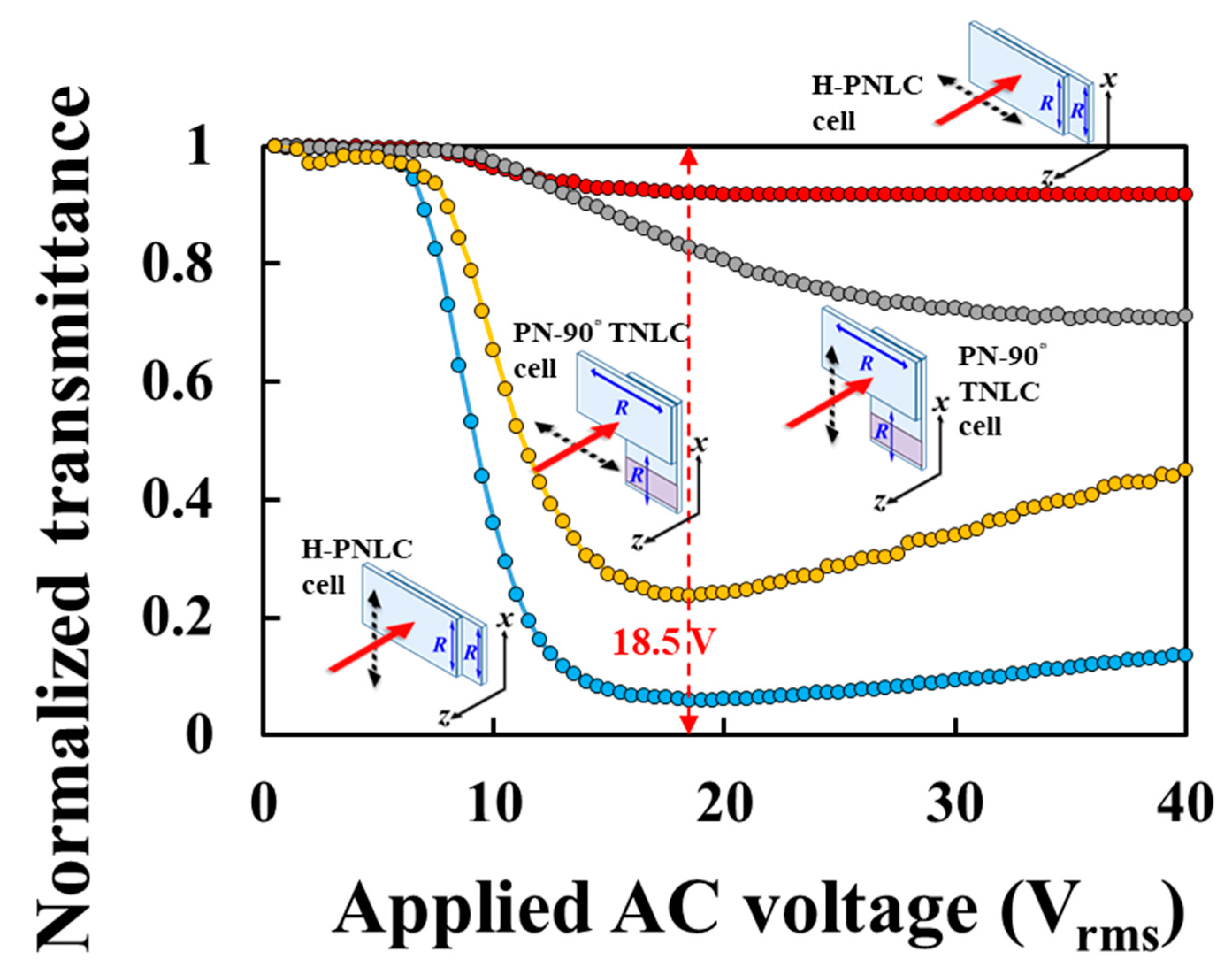
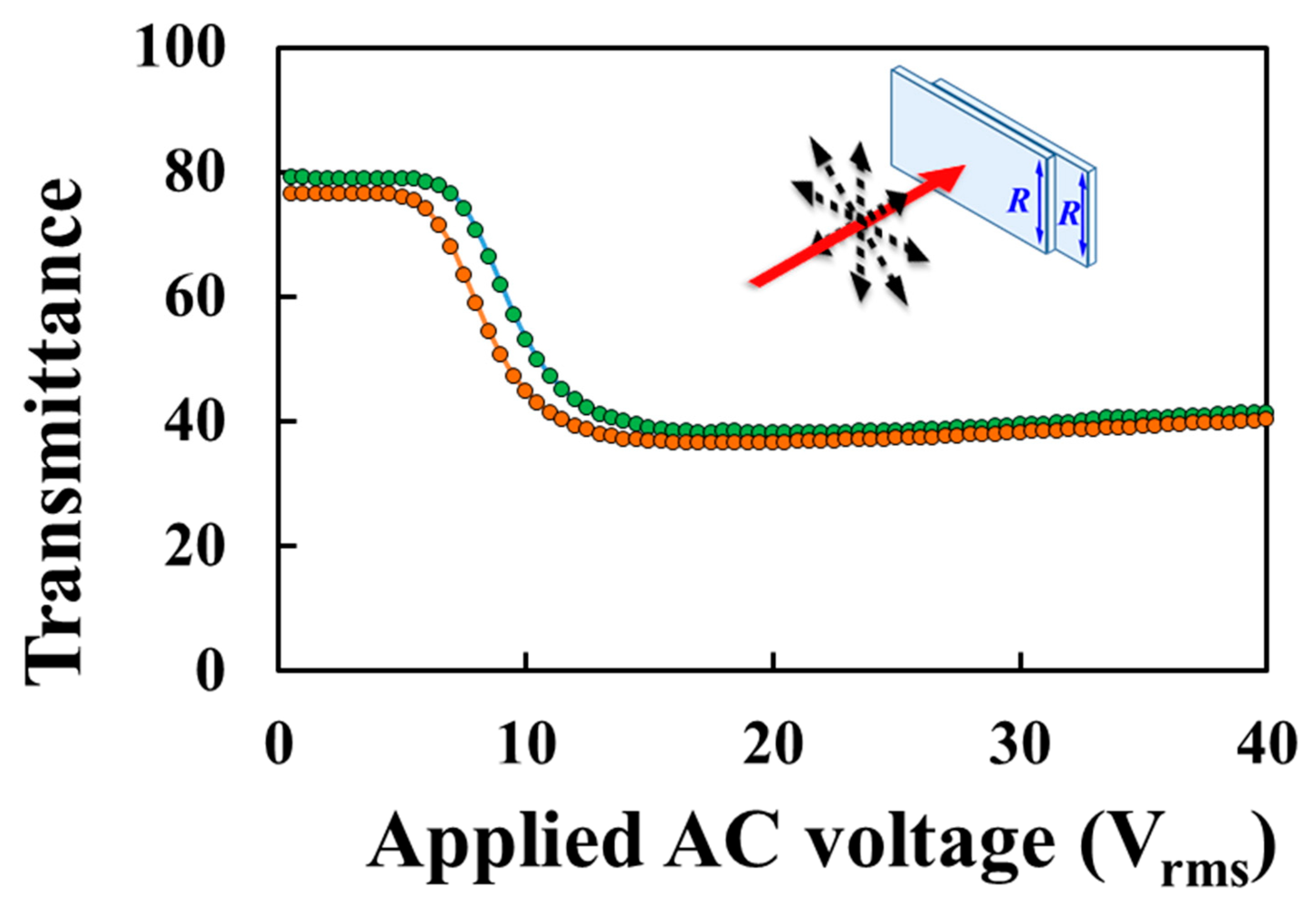
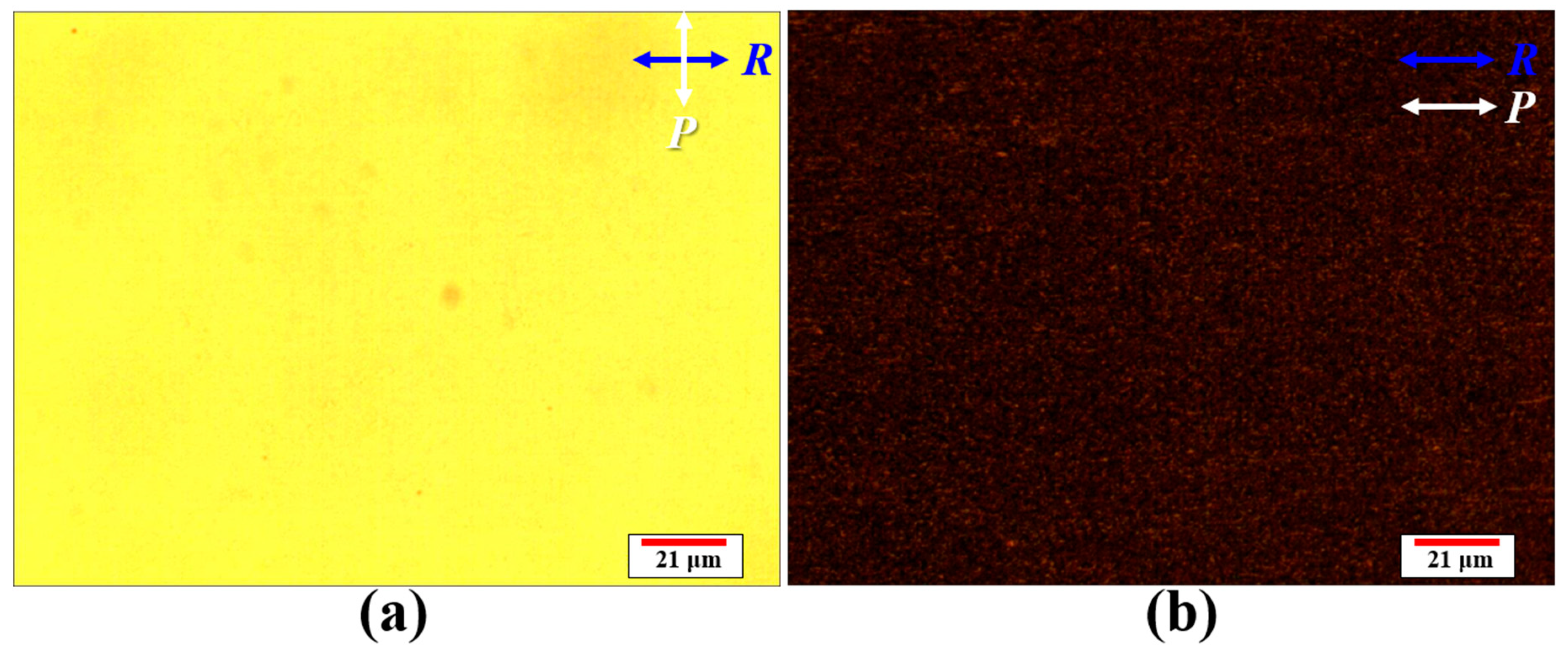

| Common ST-TRLCD | The Reported ST-TRLCD#1 Using an H-PNLC Cell (Figure 3b) | The Reported ST-TRLCD#2 Using an H-PNLC Cell (Figure 4b) | ||||
|---|---|---|---|---|---|---|
| T-mode | R-mode | T-mode | R-mode | T-mode | R-mode | |
| Output of the dark state | 0.2304α | 0.2304α +0.1152αβ +0.1152β | 0.25α | 0.125αβ | 0.125α | 0.0625αβ |
| Scattering-translucent state | Scattering-absorption state | |||||
© 2020 by the authors. Licensee MDPI, Basel, Switzerland. This article is an open access article distributed under the terms and conditions of the Creative Commons Attribution (CC BY) license (http://creativecommons.org/licenses/by/4.0/).
Share and Cite
Liu, C.-K.; Chen, W.-H.; Li, C.-Y.; Cheng, K.-T. High-Contrast and Scattering-Type Transflective Liquid Crystal Displays Based on Polymer-Network Liquid Crystals. Polymers 2020, 12, 739. https://doi.org/10.3390/polym12040739
Liu C-K, Chen W-H, Li C-Y, Cheng K-T. High-Contrast and Scattering-Type Transflective Liquid Crystal Displays Based on Polymer-Network Liquid Crystals. Polymers. 2020; 12(4):739. https://doi.org/10.3390/polym12040739
Chicago/Turabian StyleLiu, Cheng-Kai, Wei-Hsuan Chen, Chung-Yu Li, and Ko-Ting Cheng. 2020. "High-Contrast and Scattering-Type Transflective Liquid Crystal Displays Based on Polymer-Network Liquid Crystals" Polymers 12, no. 4: 739. https://doi.org/10.3390/polym12040739
APA StyleLiu, C.-K., Chen, W.-H., Li, C.-Y., & Cheng, K.-T. (2020). High-Contrast and Scattering-Type Transflective Liquid Crystal Displays Based on Polymer-Network Liquid Crystals. Polymers, 12(4), 739. https://doi.org/10.3390/polym12040739





